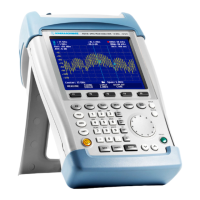7Handheld Spectrum Analyzer ¸FSH
Power measurements
The Power Sensors ¸FSH-Z1 and ¸FSH-Z18 expand the ¸FSH to a
high-precision RF power meter up to 8 GHz and 18 GHz respectively. As with
thermal sensors, the true RMS value of the measured signal is obtained over
the entire measurement range of –67 dBm to +23 dBm irrespective of the
signal waveform. In particular with modulated signals, additional measurement
errors can thus be prevented, and handling becomes easy.
Directional power measurements
The Directional Power Sensors ¸FSH-Z14 and ¸FSH-Z44 turn the
¸FSH into a full-fledged directional power meter with a frequency range of
25 MHz to 1 GHz and 200 MHz to 4 GHz. The ¸FSH can then simultaneously
measure the output power and the matching of transmitter system antennas
under operating conditions. The power sensors measure average power up
to 120 W and normally eliminate the need for any extra attenuators. They are
compatible with the common standards GSM/EDGE, 3GPP WCDMA, cdmaOne,
CDMA2000® 1x, DVB-T and DAB. Additionally, the peak envelope power (PEP)
can be determined up to a maximum of 300 W.
Measurements on cables (distance to fault)
The option ¸FSH-B1 allows the distance to any faults in an RF cable to
be determined rapidly and accurately. Distance-to-fault measurements using
the ¸FSH-Z2/-Z3 VSWR bridge give an immediate overview of the state of
the device under test (return loss and distance, see figure). The marker-zoom
function allows detailed analysis of faults with a resolution of up to 1024 pixel.
Only applies to the ¸FSH with tracking generator and options ¸FSH-B1
(distance-to-fault measurement) and ¸FSH-Z2/-Z3 (VSWR bridge) installed

